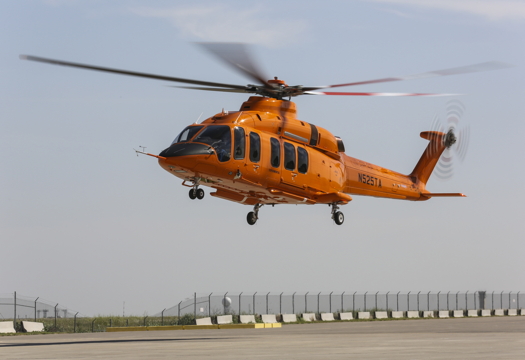
Test pilots Troy Caudill and Jeff Greenwood were at the controls of the 525 Relentless during its maiden flight on July 1. Bell Helicopter Photo
The Bell 525 Relentless has performed a successful maiden flight, taking to the air for the first time on July 1 at Bell Helicopter’s aircraft assembly center in Amarillo, Texas.
With winds gusting to 20 knots, the new super-medium helicopter executed ground taxi, hover, and low-speed maneuvers under the control of senior test pilots Troy Caudill and Jeff Greenwood, who reported that the aircraft performed “extremely well.”
“It was the test card we set out to do,” said Larry Thimmesch, Bell’s vice president for the 525 program, telling Vertical that there were “no surprises” on the initial flight. He noted that the aircraft was expected to be back in the air as early as July 2 to progress into forward flight and pattern work.
Meanwhile, the capability of the aircraft’s fly-by-wire control system — a first in the commercial helicopter market — will be progressively enabled as flight testing advances. “It’s a stepped process,” Thimmesch said.

Bell’s Larry Thimmesch said the company is making good progress in working with the FAA, EASA, and Transport Canada toward certification of the 525’s fly-by-wire flight controls. Bell Helicopter Photo
According to Thimmesch, the 525 is entering its flight test campaign with an “unprecedented” level of maturity, thanks to the groundwork laid through simulation in the Relentless Advanced Systems Integration Lab (RASIL). With many systems issues already well ironed out, the investment in simulation is “really already showing its worth,” he said.
Now, the program expects to log around 1,500 flight test hours between five prototype aircraft, the second and third of which are scheduled to fly by the end of this year. The first two flight test vehicles will be used for general performance evaluation and flight envelope expansion, while the third will be used for loads surveys — making these aircraft “the real heavy lifters for certification,” Thimmesch said.
The fourth and fifth prototypes, which are expected to fly in 2016, will be used to certify oil-and-gas and search-and-rescue mission equipment kits (with additional kits to follow after initial aircraft type certification). These production-representative aircraft will also be used for customer demonstrations.
First flight of the Bell 525 was originally planned for late 2014, but that schedule slipped in part due to supply chain issues. According to Thimmesch, no single problem caused the delay; rather, it was “the teething pains of a new program” with over 200 suppliers. “We’ve had surprises, no doubt . . . but we’ve worked through many of those challenges together,” he said.
Bell is now projecting Federal Aviation Administration (FAA) certification for the Relentless in early 2017, rather than the late 2016 timeframe originally targeted. Nevertheless, Thimmesch said, the program continues to pursue “a very aggressive schedule.” Bell has now signed more than 60 letters of intent for the aircraft, and later this year will begin building its first Relentless for customer delivery.
“Customers want the aircraft and we want to get it to them,” he said.









